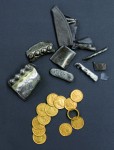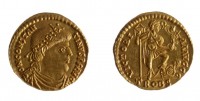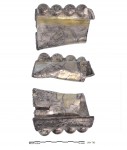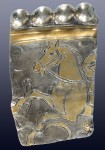 A unique hoard buried in the early 5th century in a field in modern-day Echt, in the Netherlands’ southern Limburg province, has been excavated by archaeologists from VU University Amsterdam. The first glimmers of it appeared in 1990, when a farmer working his field found two gold coins. He inadvertently dropped one of them and although he searched frantically, he couldn’t find it again. Twenty-four years later in early 2014, the farmer and his nephew returned to the find site armed with a metal detector. They discovered five more gold coins and alerted the authorities.
A unique hoard buried in the early 5th century in a field in modern-day Echt, in the Netherlands’ southern Limburg province, has been excavated by archaeologists from VU University Amsterdam. The first glimmers of it appeared in 1990, when a farmer working his field found two gold coins. He inadvertently dropped one of them and although he searched frantically, he couldn’t find it again. Twenty-four years later in early 2014, the farmer and his nephew returned to the find site armed with a metal detector. They discovered five more gold coins and alerted the authorities.
 University archaeologists excavated the rest of the hoard, getting a rare opportunity to examine the full archaeological context of a late Roman gold treasure. In fact, this is the first hoard from this period of Netherlands history to be thoroughly documented by archaeologists. The hoard is composed of one gold ring, one silver ingot, nine fragments cut from at least three large silverware plates and 12 gold coins, the most recent of which date to the reign of Emperor Constantine III (407-411 A.D.). They are in mint condition, which suggests the hoard was buried soon after 411 since the coins never had the time to get worn by circulation.
University archaeologists excavated the rest of the hoard, getting a rare opportunity to examine the full archaeological context of a late Roman gold treasure. In fact, this is the first hoard from this period of Netherlands history to be thoroughly documented by archaeologists. The hoard is composed of one gold ring, one silver ingot, nine fragments cut from at least three large silverware plates and 12 gold coins, the most recent of which date to the reign of Emperor Constantine III (407-411 A.D.). They are in mint condition, which suggests the hoard was buried soon after 411 since the coins never had the time to get worn by circulation.
 The pieces of silver tableware are what is known as hacksilver, artifacts made of precious metals that were cut up to be used as currency. One edge fragment testifies to what high level tableware it came from. It has a beaded rim and is engraved with a gilded horse and rider. The rider holds aloft a spear and the horse appears to be rearing over a lion, so archaeologists believe it was part of a larger hunting scene. Extrapolating from the curve of the outer edge of the fragment, the dish it came from would have been around 28 inches in diameter and weighed nearly five pounds. This kind of tableware was often used as diplomatic gifts to client chieftains or local dignitaries with whom Rome wished to curry favor, see the Traprain Law Hoard from East Lothian, Scotland for a famous example.
The pieces of silver tableware are what is known as hacksilver, artifacts made of precious metals that were cut up to be used as currency. One edge fragment testifies to what high level tableware it came from. It has a beaded rim and is engraved with a gilded horse and rider. The rider holds aloft a spear and the horse appears to be rearing over a lion, so archaeologists believe it was part of a larger hunting scene. Extrapolating from the curve of the outer edge of the fragment, the dish it came from would have been around 28 inches in diameter and weighed nearly five pounds. This kind of tableware was often used as diplomatic gifts to client chieftains or local dignitaries with whom Rome wished to curry favor, see the Traprain Law Hoard from East Lothian, Scotland for a famous example.
 This is the first treasure found in the Netherlands to have both gold coins and hacksilver. The latter testifies to the political and economic upheaval of the time when the hoard was buried. The reason Rome was sending out elaborately decorated, expensive tableware to the far reaches of the empire was to buy protection of the borders. A Germanic war leader would get paid in a gilded silver plate more than two feet wide, then he would cut it up for its silver value and either keep it or distribute among his soldiers just like they would any other currency.
This is the first treasure found in the Netherlands to have both gold coins and hacksilver. The latter testifies to the political and economic upheaval of the time when the hoard was buried. The reason Rome was sending out elaborately decorated, expensive tableware to the far reaches of the empire was to buy protection of the borders. A Germanic war leader would get paid in a gilded silver plate more than two feet wide, then he would cut it up for its silver value and either keep it or distribute among his soldiers just like they would any other currency.
The date of this hoard was a particularly dangerous time in the area. Many historians point to the year 406, the year of the Battle of Mainz, as the final nail in the coffin of Roman control of the Rhineland. Germanic tribes, among them the Alans, Suevi and Vandals, defeated the Franks and crossed the border of the Rhine into Gaul. Constantine III may not have been able to keep the migrating tribes out of Roman territory, but he did make some effort. Historian at the time record him distributing gold to Germanic chieftains so they would defend the Rhine border in absence of army regulars. A study of gold finds in the Netherlands support the contention, as there is a remarkable concentration of gold from the reign of Constantine III.
The owner of the Echt hoard may have been the recipient of one of these pay-offs. Constatine III was defeated in battle and executed by his successor, Constantius, in 411. In the subsequent crisis, the hoard owner may have felt the need to bury the shiny new coins and hacked up fancy silverware the former emperor had given him. He seems to have unloaded it on the gods instead.
Thanks to the in-context excavation, we know that the shallow pit in which the treasure was buried is the only place in the area where late Roman artifacts have been found. Other archaeological material has been found in neighboring fields, but not Roman pieces from the early 5th century. This indicates there was no settlement or human habitation of the area during that period. Instead, it seems the treasure was deliberately buried in this out-of-the way spot, a marshy, uninhabited lowland perfectly suited for a ritual burial. Had the hoard been buried with the intent of retrieval, it would have been found near a settlement some place where it could rediscovered with relative ease.
The hoard is now on display in the From Neanderthal to City Dwellers gallery of the Limburgs Museum in Venlo.